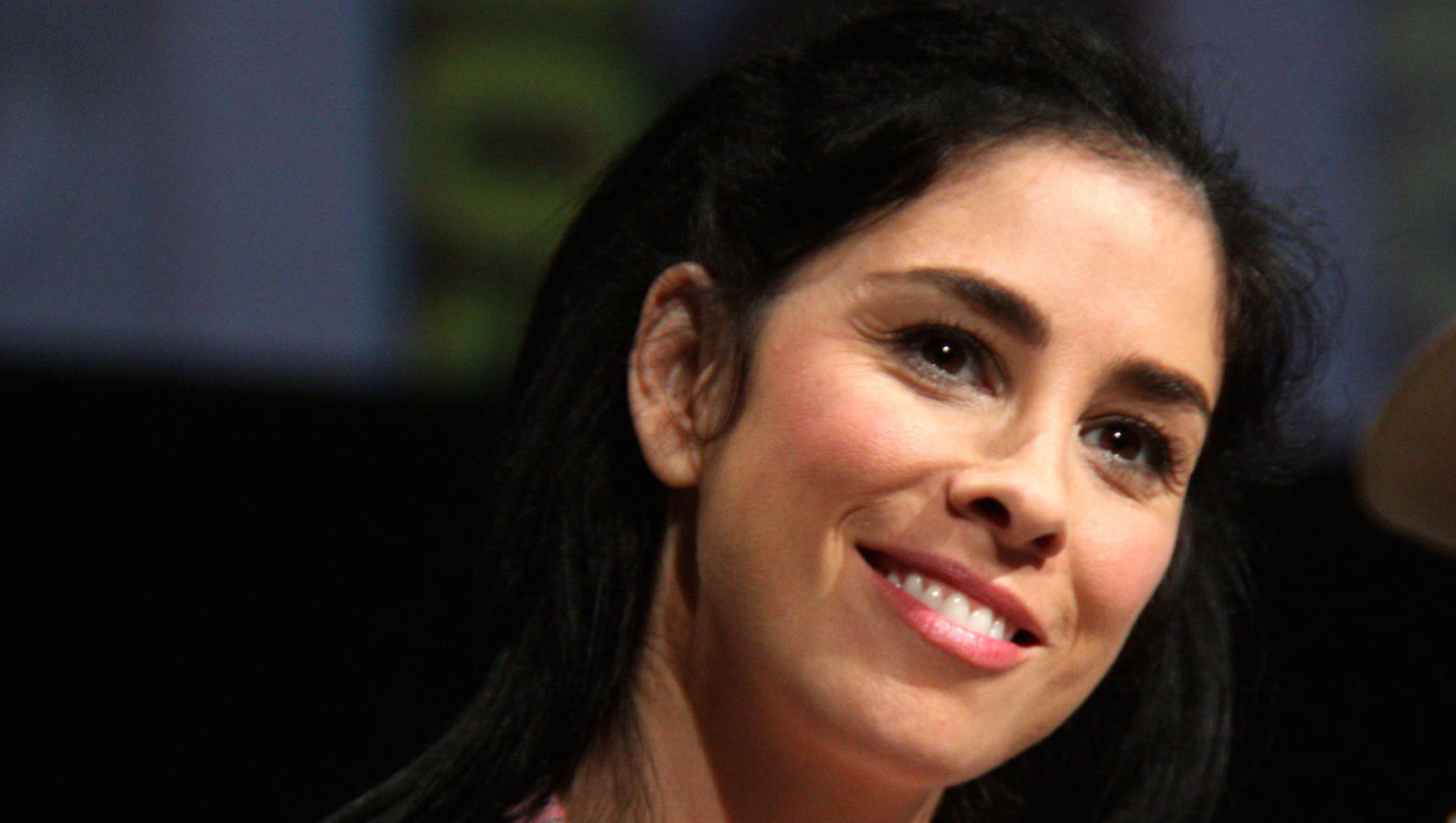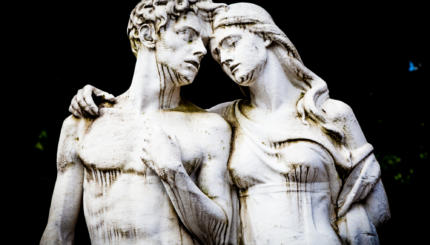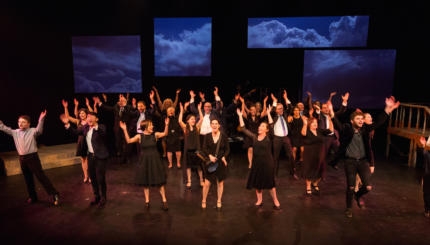Hanukkah is the festival of lights,
Instead of one day of presents, we have eight crazy nights!
When you feel like the only kid in town without a Christmas tree,
Here’s a list of people who are Jewish, just like you and me!
—Adam Sandler, “Hanukkah Song“In the ’90s, Jewish parodies on Saturday Night Live reflected two contrasting comedic impulses: the audacious Lenny Bruce and the amiable Adam Sandler.
In the Brucian tradition, Jewish writer Hugh Fink satirized network TV’s rush to air Christmas specials while ignoring Hanukkah. In his SNL sketch “And So This Is Hanukkah,” Fink had pop icon Britney Spears (played by Christina Ricci) deliver the line: “Hanukkah is a special holiday, where we as Christians take time out to think about forgiving our Jewish friends for killing our Lord.”
Reaction was swift. “The head of the Anti-Defamation League was all over the national press,” recalls Fink, who attributes the backlash to the politically-correct climate of the ’90s.
In contrast, Adam Sandler’s ethnic-pride anthem “Hanukkah Song,”–a celebratory “who’s a Jew” in song (“Some people think that Ebenezer Scrooge is / Well, he’s not, but guess who is? / All Three Stooges!”)–set off no alarms at the ADL.
Lenny’s Legacy
“Thou shall not kill. Thou shall not commit adultery. Don’t eat pork. I’m sorry, what was that last one? Don’t eat pork? Is that the word of God, or is that pigs trying to outsmart everybody?” –Jon Stewart
On January 11, 1999, Craig Kilborn, the smarmy host of Comedy Central’s late-night news parody The Daily Show, turned over the reins to whip-smart writer/comedian Jon Stewart (a.k.a. Jon Stewart Liebowitz). Stewart, who is also executive producer, writes much of his own material for the revamped show, which was renamed The Daily Show with Jon Stewart.
An adept and witty political satirist in the tradition of Mort Sahl and Lenny Bruce, Stewart lampooned news media trends with a stream of wisecracks and a team of on-location correspondents whose buffoonery recalls the residents of Chelm, the fabled Jewish village of fools.
In one example, correspondent Stephen Colbert went to Maryland to interview homeowners who were being harassed by members of a gun club. “Why can’t you live peacefully with the firing range?” Colbert asked. “They live peacefully with you, er…except for all the shooting.”
Jon Stewart often referred to his Jewish identity on The Daily Show. He opened one show by saying:
I had a discussion with a Southern gentleman today, and we were trying to find common ground… about legalizing drugs. And he said to me, ‘I think ham should be legalized.’ And I said, ‘I think ham is legal. Now, I’m Jewish, when I eat it, I don’t feel so good about myself, but I eat it.’ And it turns out, he said, ‘Hemp.’ But in a way that made me say, ‘Ham.’ And I thought to myself, ‘So that’s how the Civil War started.’ It’s the misinterpretation.
Stewart’s love of clever wordplay, a Jewish comedic tradition, also colored his prose fiction. Like many comics of the ’90s, he wrote a book of short humorous pieces. Released in 1998, his Naked Pictures of Famous People includes a number of pieces in which protagonists wrestle with their Jewish identity.
“Sick Humor”
Another comedy trend of the ’90s — “sick humor” — owes its inspiration to Lenny Bruce. Turning the tables on the politically-correct mindset of the ’90s, comedians like Dave Attell and radio “shock jocks” like Howard Stern — both Jewish –transformed taboo into titillation. Equal opportunity offenders, they smashed the sacred cows of the right and left wings with equal fervor.
“Sometimes, for lack of a better word, people call [this comedy] ‘sick,'” says humor writer Tom Leopold, “but, in fact, it’s just so purely honest it’s hilarious, because it says what we all think, but can’t say. Lenny Bruce did that.”
Dave Attell, acclaimed by The New York Times magazine in 1994 as one of the 30 most brilliant artists under 30, performed the “Ugly American” segments on The Daily Show with Jon Stewart and wrote and starred in a Comedy Central series, Insomniac with Dave Attell — exactly the kind of television Lenny Bruce would have craved. Each 30-minute show followed Attell as he enters America’s nocturnal world, populated by hookers, strippers and junkies.
South Park
Comedy Central is also the home of South Park, an animated satire of small-town America from the perspective of a quartet of foul-mouthed children. Created in 1997 by Trey Parker (non-Jewish), and Matt Stone (Jewish), this “sick comedy” largely appeals to Generation X and their younger peers precisely because of its blunt satire of the hypocrisy employed by adults to achieve selfish ends.
Stone, who writes many of the show’s scripts, is the voice of Kyle Broflovski, son of the only Jewish family in South Park. (His father wears a red kipah, and his mother is a typical yenta.)
In one episode, Kyle questions the existence of God when he becomes deathly ill with hemorrhoids, while his cruel friend Eric Cartman (voiced by Trey Parker) inherits a million dollars and buys his own amusement park. In South Park Synagogue, Kyle stuns his best friend Stan Marsh (Trey Parker) with the following soliloquy:
… All my life I was raised.. .to believe we should all behave a certain way, and good things would come to us. I make mistakes, but every week I try to better myself…. And what does this so-called God give me in return? A hemorrhoid!
To comfort Kyle, his parents tell him the story of Job, whose faith was similarly tested, but Kyle is unimpressed. By the end of the episode, however, Cartman loses all his money, and Kyle’s health — and faith — is restored. The lesson: The meek (and the faithful) will inherit the earth, while the Cartmans will fall victim to an unbending moral universe that does not tolerate evil.
This is, in fact, the moral of many a South Park episode. Cartman, who represents evil incarnate, regularly schemes to victimize the more goodly residents of South Park; by the end of the episode, he ends up with nothing.
Standup Becomes Alternative
“The Jewish concept of God is too difficult to fathom. An omniscient, omnipotent Peeping Tom who loves us and smites our enemies. Although recent history suggests he’s a little slow on the smiting.” –from Naked Pictures of Famous People by Jon Stewart
The golden age of standup in the ’70s and the comedy club boom in the ’80s began to decline in the ’90s as audiences turned to cable TV for comic relief. Many standup comics quit the business, but those who were in it for the art, not the money, stuck around and honed their craft, helping to create an alternative comedy movement in the mid-’90s.
New clubs, such as Rebar and the Luna Lounge in New York, featured Jewish comedians Marc Maron (Almost Famous, The Late Show with David Letterman), Sarah Silverman (There’s Something About Mary), and Jeffrey Ross (Comedy Central Presents: The New York Friars Club Roasts), among others.
In these alternative venues, comedians rarely performed rehearsed, “safe” TV routines. Sarah Silverman, for example, once came onstage with fellow Jewish comedian Sam Seder dressed as Seder’s teenage nephew, a bar mitzvah boy who complains: “My friends don’t even know who you are! Adam Sandler is funny, and you are not funny! I wish that Adam Sandler was my uncle! You suck, and Adam Sandler rocks!”
Industry bigwigs began flocking to these alternative spaces, hoping to cash in on what might become “the next big thing.” Silverman soon landed a spot writing and performing on Saturday Night Live, which led to film roles; Ross became a regular presence on Comedy Central; and Marc Maron’s one-man show, The Jerusalem Syndrome, enjoyed a sold-out off-Broadway run and, in 2001, was published as a book.
The more mainstream standup comedy clubs continued to headline Jewish comedians — including Susie Essman, Lewis Black, Hugh Fink, and Judy Gold — who were influenced by their counterparts in the alternative movement. Gone was the era of simple, Seinfeldian observational comedy. A new type of edgy, intellectual humor was on the rise, one that still made observations but also crossed the line into a more philosophic realm.
Consider Hugh Fink’s “Pizza” joke: “I don’t like the way people are now using September 11th as an excuse. I was in Phoenix last week, and I ordered a pizza. I said, ‘Half pepperoni and half cheese.’ The guy came in half an hour later, and I said, ‘Hey, this is sausage. I said half pepperoni and half cheese.’ And he goes, ‘Um, due to the recent tragedy of September 11th, we forgot to put pepperonis on.'”
Adapted with permission from Reform Judaism magazine.

Help us keep Jewish knowledge accessible to millions of people around the world.
Your donation to My Jewish Learning fuels endless journeys of Jewish discovery. With your help, My Jewish Learning can continue to provide nonstop opportunities for learning, connection and growth.



